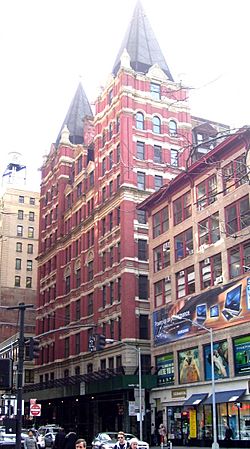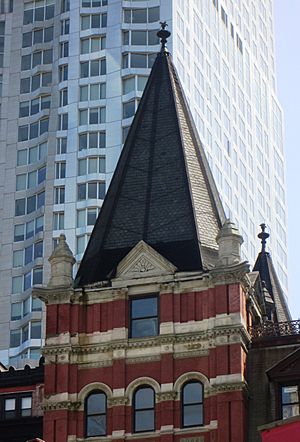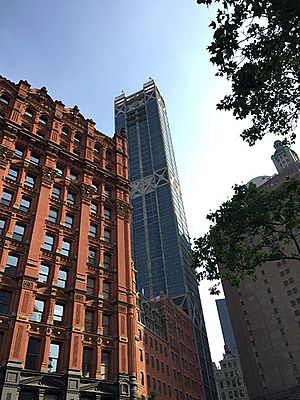5 Beekman Street facts for kids
Quick facts for kids 5 Beekman Street |
|
|---|---|

The Temple Court Building and Annex form the original portion of 5 Beekman Place.
|
|
| Alternative names | Temple Court Building and Annex Beekman Hotel and Residences |
| General information | |
| Location | Manhattan, New York |
| Address | 3–9 Beekman Street 115–133 Nassau Street 10 Theatre Alley |
| Coordinates | 40°42′40″N 74°00′25″W / 40.7112°N 74.0070°W |
| Construction started | 1881 (original building) 1889 (annex) 2014 (tower) |
| Completed | 1883 (original building) 1890 (annex) 2016 (tower) |
| Height | |
| Roof | 687 feet (209 m) |
| Technical details | |
| Floor count | 51 |
| Design and construction | |
| Architect | Benjamin Silliman Jr. and James M. Farnsworth (Temple Court Building) Gerner Kronick + Valcarcel Architects (tower) |
|
Temple Court Building
|
|
|
U.S. Historic district
Contributing property |
|
| Location | Nassau and Beekman Sts, Manhattan, New York |
| Built | 1881–1883; 1889–1890 |
| Architect | Benjamin Silliman Jr. and James M. Farnsworth |
| Architectural style | Queen Anne, neo-Grec, Renaissance Revival |
| Part of | Fulton–Nassau Historic District (ID05000988) |
| Significant dates | |
| Designated CP | September 7, 2005 |
5 Beekman Street, also known as the Beekman Hotel and Residences, is a cool building in the Financial District of Manhattan, New York City. It's actually two parts connected together. There's the old 10-story Temple Court Building and Annex and a new, super tall 51-story tower called the Beekman Residences.
The Temple Court Building is 150 feet (46 meters) tall. The new Beekman Residences tower is much taller, reaching 687 feet (209 meters). The building has 68 apartments, called condominiums, in the tower. The Beekman Hotel has 287 rooms and is located in both parts of the building.
The original Temple Court Building was designed by Benjamin Silliman Jr. and James M. Farnsworth. It has a base made of granite and red brick walls above. It also has cool stone and terracotta decorations. The annex part was designed by Farnsworth and has limestone walls. Inside, there's a special open space called an atrium with a glass roof, called a skylight.
The Temple Court Building was built between 1881 and 1883. The annex was added later, from 1889 to 1890. It was first used for lawyers' offices. In 1997, the old building became a special New York City landmark. This means it's protected because of its history and design. The building was empty for a while after 2001. Then, it was bought and sold many times and even used for filming movies and TV shows! The new tower was built from 2014 to 2016. The old building was also fixed up and reopened in 2016.
Contents
Location of 5 Beekman Street
5 Beekman Street is in the Financial District of Manhattan. It's right next to New York City Hall and City Hall Park. The building is surrounded by Nassau Street to the east, Beekman Street to the north, and Theatre Alley to the west.
Many other famous buildings are nearby. The Morse Building and 150 Nassau Street are across the street. The Potter Building and 41 Park Row are directly across Beekman Street. The Park Row Building is to the southwest.
The Temple Court Building itself is about 150 feet (46 meters) long on Nassau Street. It is 100 feet (30 meters) deep on Beekman Street. The new Beekman Residences part is about 50 feet (15 meters) long. In total, 5 Beekman Street is 200 feet (61 meters) long and 100 feet (30 meters) deep.
What 5 Beekman Street Looks Like
5 Beekman Street has two main parts. The Temple Court Building is ten stories tall. It has nine full floors. There are two pointy towers on the corners that have a tenth floor inside them. The Temple Court Building is 150 feet (46 meters) tall to the top of its roofs. Most of the 287 rooms for the Beekman Hotel are in this older part.
Right next to the Temple Court Building is the Beekman Residences tower. This tower is 51 stories tall and reaches 687 feet (209 meters) high. It holds the rest of the hotel rooms and 68 apartments.
Temple Court Building and Annex
The older part of the building, the Temple Court Building, is made of red brick and terracotta. It mixes different old styles like Queen Anne and Renaissance Revival. It was first used for offices. Benjamin Silliman, Jr. and James M. Farnsworth designed this part.
The annex, which is the part added later, has limestone walls. It was designed by James M. Farnsworth alone. The Temple Court Building and Annex has 165,000 square feet (15,300 square meters) of space. It was one of the first tall buildings that was built to be fireproof. It was also one of the few buildings from the late 1800s to have a large open atrium with a skylight in the middle.
Building Shape and Outside Look
The original building has an atrium that goes up through all nine stories. It has a big pyramid-shaped skylight on top. The building has three main sections on the outside. The bottom two floors are made of granite. The floors above are made of brick and terracotta.
The building has ten sections, called bays, on Nassau Street and nine on Beekman Street. The corners of the building stick out a little, like small towers. The bottom two floors have main entrances and shops. The middle four floors have brick walls with terracotta decorations. The top four floors have a special roof called a mansard roof with windows sticking out. The corners have pointy slate roofs that look like pyramids. These roofs were meant to make the building look shorter.
The annex has walls on Nassau Street and Theatre Alley. The Nassau Street side is made of limestone. It used to have an arched entrance, but now it's a shop entrance. The Theatre Alley side is made of brick with rectangular windows.
Inside Features
The atrium in the middle of the building is a large open space. You can get to it from the main entrance on Beekman Street. The balconies around the atrium have cool tile floors and iron railings. These railings are held up by brackets shaped like dragons! There are also metal grilles with leaf patterns. The atrium was covered up for many years but was uncovered and fixed up in the 2010s.
Around the atrium were offices. There were 212 offices in total. These rooms had tall ceilings and even fireplaces. There was also a special shaft with trapdoors on each floor. This was used to move heavy safes from the basement. The building had three elevators near the atrium. The annex had two more elevators. In the basement, there was a large vault with two sets of locks.
The building was considered very fireproof. It had iron floor beams and thick brick walls. Iron and terracotta blocks were also used to protect the annex from fire.
Beekman Residences
South of the old Temple Court Building is the new Beekman Residences tower. It was finished in 2016 and designed by Gerner Kronick + Valcarcel Architects. This tower is very tall because it used "air rights" from the Temple Court Building. This means it could build higher because the old building didn't use all its allowed height.
The tower has two pyramid-shaped peaks at the very top, each 50 feet (15 meters) tall. These were inspired by the pyramid roofs on the old Temple Court Building. The outside of the tower is made of concrete, glass, and metal. It has tall windows between concrete sections. Some parts of the tower have special patterns carved into them, like the designs in the old building's atrium.
The Beekman Residences has 68 apartments, called condominiums, above the 17th floor. These apartments have windows on two sides of the tower. They also have tall 10-foot (3.0 meters) ceilings and oak floors.
Hotel and Restaurants
The Beekman Hotel has 287 rooms. Most of these rooms are in the old Temple Court Building. But 75 rooms are also in the lower floors of the new Beekman Residences tower. Two special hotel suites are located right under the roofs of the Temple Court Building.
On the 11th floor, there's a terrace on the roof of the Temple Court Building. There are also private dining rooms and media rooms for guests.
5 Beekman Street also has two restaurants. They are run by famous chefs Keith McNally and Tom Colicchio. McNally's restaurant, The Augustine, opened in 2016. Colicchio's restaurant, Temple Court, also opened in 2016.
History of 5 Beekman Street
Early Days and Construction
The land where 5 Beekman Street stands has a long history. It was once part of New York City's first theater area. A theater built here in 1761 even hosted the first showing of Hamlet in the United States! Later, a company called Fowler & Wells, which published books, was on the site.
In 1830, the New York Mercantile Library built a hall called Clinton Hall here. By the late 1800s, this area became known as "Newspaper Row." Many newspaper companies had their main offices nearby.
In 1881, a rich businessman named Eugene Kelly bought the land. He hired Silliman and Farnsworth to build a 10-story office building. It was first called the "Kelly Building." Construction started in May 1881. The building was supposed to be finished by May 1882, but there were delays. A bricklayers' strike happened, and a fire in a nearby building was blamed on wind from the construction site.
In March 1882, the building was renamed the Temple Court Building. It was said to be designed for lawyers' offices. The Temple Court Building was finished in May 1883. It cost $750,000 to build.
Because the building was so popular, Kelly bought more land in 1886. Farnsworth then designed a 10-story annex to the building. This new part was finished by May 1890.
As an Office Building
The Temple Court Building was designed to attract lawyers. It was close to the courts, which was perfect for them. For many years, it was considered one of the best office buildings in the city. Other types of businesses also had offices there, like labor unions and insurance companies.
In 1893, a fire started in the annex. It was likely caused by an electric wire. The fire damaged the top four floors of the annex. Luckily, no one died. The building's main structure was not damaged. This fire was important because it was one of the biggest fires in a "fireproof" building at the time.
When Eugene Kelly died in 1895, his family took over the building. In the mid-1900s, walls were put up inside the building. These walls covered up the beautiful central atrium and its skylight. This was done for fire safety reasons. The building was also changed in other ways, hiding some of its original decorations.
By the early 1990s, the building was renovated. Many of its original decorations were brought back. In 1998, the Temple Court Building and its annex officially became a New York City landmark. The last tenant moved out in 2001, and the building became empty.
Bringing the Building Back to Life
In 2008, new owners bought 5 Beekman Street. They planned to turn it into a hotel. While the building was empty, it became very popular with "urban explorers" and photographers. People loved to take pictures inside because the old atrium was so beautiful.
The building was used for many photo shoots, including for fashion magazines. It was also a backdrop for TV shows like White Collar and Law & Order. Even a music video for Kanye West was filmed there! These events brought in a lot of money.
In 2012, GFI Capital Resources bought the building. They planned to turn the Temple Court Building into a hotel. They also bought the land next door to build a new tower.
Work on the new Beekman Residences tower started in 2014. The tower and the old building were combined into one complex, the Beekman Hotel and Residences. The Temple Court Building was also fixed up. Its skylight was replaced, and the atrium was restored with its original tiles and decorations.
The Beekman Hotel opened in August 2016. The two restaurants inside opened two months later. By 2017, almost all the apartments in the new tower were sold. The most expensive apartment, a penthouse, sold for $12.5 million in 2020.
Images for kids
See also
 In Spanish: The Beekman para niños
In Spanish: The Beekman para niños




